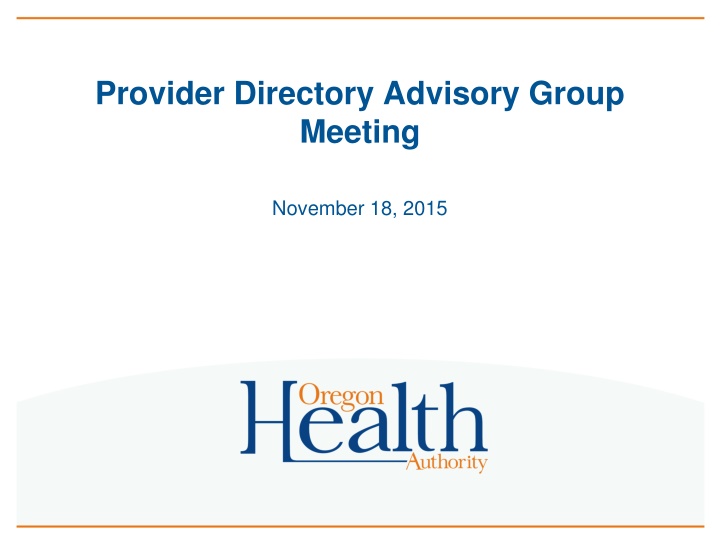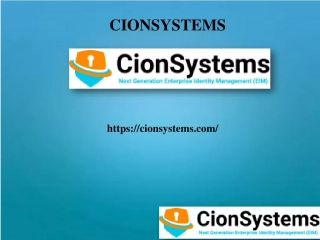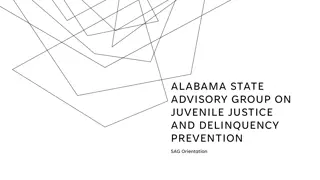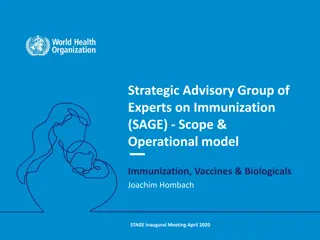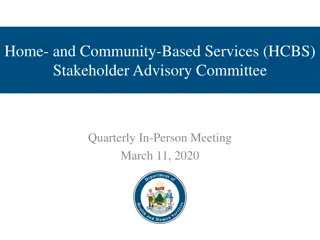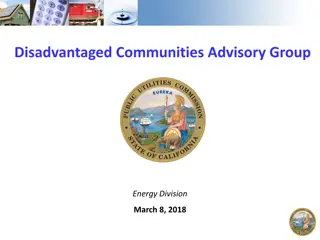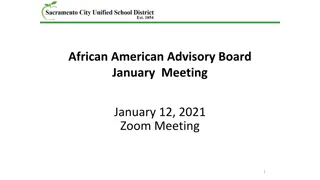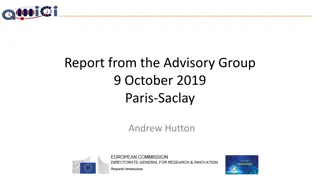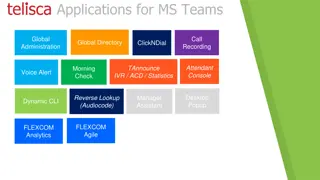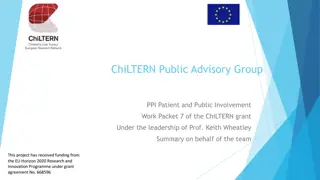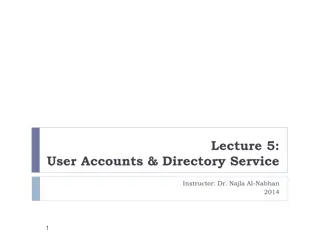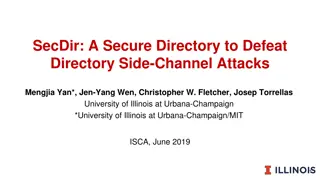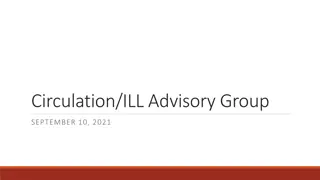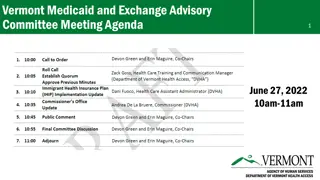Provider Directory Advisory Group Meeting Summary
The Provider Directory Advisory Group Meeting held on November 18, 2015, covered various topics including Clinical Quality Metrics, Registry Presentation, Procurement updates, and Common Credentialing. The meeting involved breakout sessions, group discussions, and group presentations focusing on refining use cases. Participants engaged in hands-on activities and presentations to enhance their understanding and contribute to the broader PDAG community.
Download Presentation

Please find below an Image/Link to download the presentation.
The content on the website is provided AS IS for your information and personal use only. It may not be sold, licensed, or shared on other websites without obtaining consent from the author.If you encounter any issues during the download, it is possible that the publisher has removed the file from their server.
You are allowed to download the files provided on this website for personal or commercial use, subject to the condition that they are used lawfully. All files are the property of their respective owners.
The content on the website is provided AS IS for your information and personal use only. It may not be sold, licensed, or shared on other websites without obtaining consent from the author.
E N D
Presentation Transcript
Provider Directory Advisory Group Meeting November 18, 2015
Welcome! Agenda review: Introductions welcome Peter Graven! Breakouts for use refining and prep for larger group discussion Group report-outs Clinical Quality Metrics Registry Presentation Break Procurement update Common Credentialing update Fees orientation Wrap up, updates, and next steps for December 2
Use Cases Use refining and prep for larger group discussion 3
Handouts for group exercises Use case packets Standards matrix updates Network adequacy updates in Oregon start in January 2017 Updated data element matrix with Common Credentialing practitioner types Parking lot 4
Group discussions Write your name on your assigned use case and worksheet: Plans - Validation data sets (8) HIE - Provider searches for DSM addresses (6) Analytics - Provider data sets for analytics (24) Delivery - Provider searches (15/16) Groups will have 30 minutes to review the use case Select a presenter from your group to walk through/present their priority use to the broader PDAG 5
Overview of Clinical Quality Metrics Registry (CQMR) Crystal Nielson, Lead Policy Analyst Office of Health Analytics Office of Health Information Technology
Discussion Outline Oregon s Quality and Measurement Strategy Clinical Quality Measure (CQM) Reporting Requirements Future State Vision for HIT Optimized Health Care System Clinical Quality Metrics Registry (CQMR) Overview 8
QUALITY AND MEASUREMENT STRATEGY 9
Selection of CCO Metrics Set Metric set needed to measure Oregon s Transformation efforts: CMS to evaluate Oregon s progress Oregon to evaluate CCO performance Metrics and Scoring Committee is responsible for identifying and adopting metrics Committee identified an initial set of 17 CCO metrics Three measures are based on clinical data (the majority are claims or hybrid measures) NQF 0418 Screening for Clinical Depression and Follow-up Plan NQF 0059 Diabetes Poor Control NQF 0018 Controlling Hypertension 10
Clinical Quality Measures Three measures in the initial CCO Metric Set are based on clinical data (the majority are claims or hybrid measures) NQF 0418 Screening for Clinical Depression and Follow-up Plan NQF 0059 Diabetes Poor Control NQF 0018 Controlling Hypertension Efforts in place to develop custom measures for: SBIRT OHA reviewed draft federal measures Completing draft specifications for custom measure in Q4 of 2015 Two rounds of pilots in 2016 Implementation of EHR-based measure reporting beginning with 2017 Tobacco Prevalence/Cessation Utilizing data collection process for the Smoking Objective Submitting test data 11
Incremental Approach to eReporting Reporting clinical data requires new processes and capacity A key decision point was the plan for collecting CQM data Chart review vs. electronic reporting? Electronic reporting will: Enable population-based measurement Automate the reporting process Need to develop technology solution for collecting CQM data while implementing waiver requirements: working with what we have Desire to meet stakeholders where they were and allow for necessary capacity building 12
CQM REPORTING REQUIREMENTS 13
Implementing CQM Reporting CCOs required to submit: Pre-Submission Narrative Data Submission Percentage of incentive payment has been payable upon approval of pre-submission documents Year Three (2015) is first year that there is no pay-for-reporting component, payment will be performance based Incremental increases in reporting requirements over each program year 14
Submission Process Data is due to OHA on April 1st following the program year (May 1st in Year One) CCO manually uploads files to a secure FTP site In Year Two (2014), most CCOs submitted data: Aggregated at the physical location (one CCO submitted patient- level data) For the full calendar year For CCO Medicaid beneficiaries only From custom query 16
THE CQMR AND CQM REPORTING IN FUTURE YEARS 17
CQMR Overview The Clinical Quality Metrics Registry (CQMR) will electronically collect, aggregate, display, and export clinical quality measure data in order to support an HIT-optimized health system Technology includes: Database Web-based Portal Emphasis on functionality & standards utilized by ONC certified HIT for reporting of CQM data CMS eCQM Specifications Capture, calculate, and report certification criteria (including Quality Reporting Data Architecture format) Procurement occurring in coordination with other HIT portfolio projects (e.g., Common Credentialing, Provider Directory) 18
eReporting of CQMs to CQMR CCOs, providers, data intermediaries will submit clinical data to meet quality program reporting requirements Quality programs will utilize data to determine eligibility for incentive payments CCO Incentive Metrics Program (Program Year 2016) EHR Incentive Program (Program Year 2018) Considering use for other programs Improve access to clinical quality measure data and the ability to utilize standardized data for analytics/quality improvement initiatives Enable a report once strategy to streamline reporting requirements among multiple quality programs 19
CQMR & Provider Directory OHIT anticipates that CQMR will be a data source for Provider Directory (and perhaps vice versa) CQMR will provide account/access management information that includes provider affiliations to CCOs and clinics QRDA standard includes a number of data fields related to provider demographics Limitation is data timeliness measure data will be submitted to the CQMR annually (some discussion around quarterly submissions) As projects develop, additional connections may be identified 21
Crystal Nielson, MPA: HA Lead Analyst CQMR crystal.nielson@state.or.us (971) 304-9627 22
Procurement Updates Rachel Ostroy Implementation Director 24
HIT Portfolio Upcoming Milestones QA Vendor (CSG) onboard System integrator (Harris) contract Stage Gate 3 submission Harris begins planning phase Provider Directory RFP CC vendor selection Fall 2015 (Q4) Winter 2016 (Q1) Spring 2016 (Q2) Summer 2016 (Q3) Provider Directory (PD) Market Analysis Common Credentialing (CC) RFP CC Implementation PD vendor selection 25
Common Credentialing Updates Melissa Isavoran Credentialing Project Director 26
Current progress Advisory Committee on Physician Credentialing Information recommended nonsubstantive form changes to be brought to the CCAG for review on 11/20 Delegation agreements may impact program viability Fee structure development work continues with identifying logistics for tiered set-up fees Provider data alignment discussions with stakeholders identified consensus of value in exploring additional data collection through common credentialing value vs. complexity
Timeline for the Oregon Common Credentialing Program (OCCP) Convened the Common Credentialing Advisory Group 2/1 2/1 Report to Legislature Report to Legislature 7/1 10/1 1/17 Developed Rules 2/5 Report to Legislature Request for Information Issued SB 594 Introduced Sept 2013 Q1 2014 Q2 2014 Q3 2014 Q4 2014 Q1 2015 Development & Implementation Plan 2/8 6/30 3/1 3/31/17 Marketing and Outreach Rulemaking Process 5/29 2/1 10/1 SB 594 Passed Go Live Date Report to Legislature Report to Legislature Q2 2015 Q3 2015 Q4 2015 Q1 2016 Q2 2016 Q3 2016 Q4 2016 1st Qtr 2017 Requirements and Contract Planning and Sub-Vendor Implementation Common Credentialing Vendor Contract 12/31 Prime Contract Amendment Final Report OHPR 8.5.15
Common Credentialing Fees Melissa Isavoran Credentialing Project Director 29
Fee Authority Senate Bill 604 requires OHA to develop rules on the imposition of fees, not to exceed the cost of administering the Oregon Common Credentialing Program (OCCP), on health care practitioners who submit credentialing information to the database and credentialing organizations that access the database.
Current Fee Structure Practitioners generally do not pay for credentialing, BUT: Privileging is supported by fees and includes credentialing Some credentialing costs are built into provider payments Practitioners pay for office staff hours to complete credentialing paperwork and required follow up
Fee Structure Development OHA developed high-level fee structure options by: Consulting subject matter experts and the CCAG on fee structure principles to use as guidelines and options, Researching market fee structures, and Assessing Request for Information responses to fee structure questions: Not a lot of consistency in responses Total cost ranges varied greatly Some structures conflicted with principles due to inequities (e.g., annual Maintenance fees) Some structures (e.g., enterprise fees) not feasible as they considered number of credentialing organization users, which would actually be small
Fee Structure Principles (at a high level) Fees should be balanced considering benefits and resources Ensure that costs are not a barrier to participation Fees should be equitably balanced between provider types and credentialing organization types and sizes Fees must be efficient and economical to administer Fees should be transparent and justifiable in development Fees should be stable and produce predictable income to support the costs of operating common credentialing which should include allocations for information technology and operational quality assurance activities and security Individually requested processes must be borne by those making such requests
Fee Structure Options FEE OPTIONS Credentialing Organizations One-Time Setup Fee STRUCTURE Flat Fee Tiered Fee Flat Fee, + Amortization Flat Fee Tiered Fee; based on Practitioner Type Flat Fee Transactional Fee (ongoing operations and maintenance costs) Expedited Credentialing Fee Health Care Practitioners Initial Application Fee Flat Fee Tiered Fee; based on Practitioner Type Delegation Agreements Capitated Fee? Data Users Data Use Fee Annual Capitated Fee? Undetermined
Next Steps for Fee Structure Development Development of Credentialing Organization fee structure tiers Rulemaking Advisory Committee Develop rules Submit Notice of Proposed Rules to Secretary of State Public rules hearing Publish final rules Legislative approval process (2017)
Provider Directory Fee Principles Discussion 36
Principle 1 Fee development for credentialing organizations and providers must be delicately balanced considering the benefits they may experience and their respective resources Questions for the PDAG (potential edits) Is there a distinction for the provider directory between orgs and providers? 37
Principle 2 Ensure that costs are not a barrier to participation Questions for the PDAG: What about costs that are considered to be unfair government competition? Would the PD be in competition? 38
Principle 3 Fees should be equitably balanced between different organization types considering their required level of participation Questions for PDAG: Different organization types Independent Physician Associations (IPAs), individual clinics, hospital and health systems, regional HIEs? Different uses? Different levels of access? Other? 39
Principle 4 Fees for health care organizations should be equitably balanced consider the size and types of its health care organization Questions for PDAG: Different organization types Independent Physician Associations (IPAs), individual clinics, hospital and health systems, regional HIEs? Different uses? Different levels of access? Other? 40
Principle 5 A specific portion of the fees should be specifically allocated for information technology and operational quality assurance activities Questions for PDAG: Specify more here? Enhancements, maintenance, data management and ongoing operations 41
Principle 8 Fees should be stable (not vary considerably year to year) and predictable with changes based only on scope adjustments, CPI increases, and increases in participants Question for PDAG: Do we want to be this specific? Are the items specified the ones we d have? 42
Principle 9 Fees should produce a predictable income to support the costs of operating the provider directory which should include allocations for information technology and operational quality assurance activities and security. Questions for PDAG: Operating, maintaining, and enhancing? Security? 43
Next steps Finalize principles Draft fee structure options and considerations for the provider directory based on November meeting input Fee types Description Structure Benefits Challenges Consideration December meeting in depth fee structure conversation. Bring a fee friend 44
Updates and next meeting Karen Hale
PDAG 2016 meeting dates and locations Date January 13, 2016 February 17, 2016 March 16, 2016 April 13, 2016 May 18, 2016 June 15, 2016 July 13, 2016 August 17, 2016 September 14, 2016 October 12, 2016 November 16, 2016 December 14, 2016 Location Portland PSOB Room 1A Woodburn Portland PSOB Room 1E Woodburn Portland PSOB Room 1E Woodburn Portland PSOB Room 1E Woodburn Portland PSOB Room 1E Woodburn Portland PSOB Room 1E Woodburn 46
PDAG/CCAG Nominations 3 current vacancies on the Common Credentialing Advisory Group (CCAG) and 1 current vacancy on the PDAG OHA will arrange a joint CCAG/PDAG nomination/application process PDAG is looking for a provider representative CCAG is looking for a Hospital representative, health plan representative, and an Independent Physician Association (IPA) representative 47
